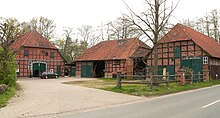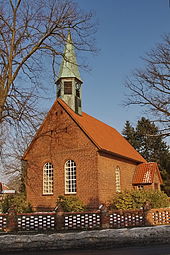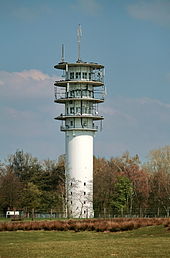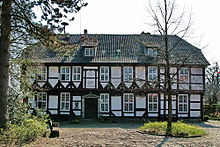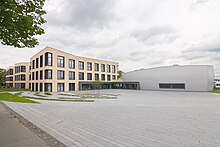Wedemark
| coat of arms | Germany map | |
|---|---|---|
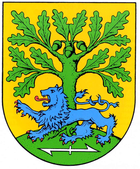
|
Coordinates: 52 ° 32 ' N , 9 ° 43' E |
|
| Basic data | ||
| State : | Lower Saxony | |
| County : | Hanover region | |
| Height : | 48 m above sea level NHN | |
| Area : | 173.36 km 2 | |
| Residents: | 29,582 (Dec. 31, 2019) | |
| Population density : | 171 inhabitants per km 2 | |
| Postal code : | 30900 | |
| Primaries : | 05130, 05072 , 05131 | |
| License plate : | H | |
| Community key : | 03 2 41 019 | |
| LOCODE : | DE WDE | |
| Community structure: | 17 districts | |
| Address of the municipal administration: |
Fritz-Sennheiser-Platz 1 30900 Wedemark |
|
| Website : | ||
| Mayor : | Helge Zychlinski ( SPD ) | |
| Location of the community Wedemark in the Hanover region | ||
Wedemark is a municipality in the Hanover region , Lower Saxony , with its administrative headquarters in the Mellendorf district . The community name refers to the historical landscape designation of the Wedemark. Since 2008, the municipality of Wedemark has had the status of an independent municipality by resolution of the state government .
geography
Geographical location
The municipality of Wedemark borders on Burgwedel , Isernhagen , Langenhagen , Garbsen and Neustadt am Rübenberge (all Hanover region ) as well as Lindwedel ( Heidekreis district ) and Wietze ( Celle district ) (clockwise, starting in the east).
Community structure
The municipality of Wedemark is divided into the following districts:
|
|
(Population figures as of December 31, 2015)
history
Today's municipality of Wedemark was created through the voluntary amalgamation of several settlements for mutual protection and assistance. The name "Wedemark", which refers to a " mark ", a border area, is said to go back to the Billunger noble family who ruled the Saxon districts between 950 and 1106 . The location or even the existence of the Billunger's mark has not been proven. In the middle of the 16th century, the Bissendorf District Bailiwick was established in the eastern part of Wedemark. They and the Burgwedel District Bailiwick were subordinate to the ducal bailiwick in Celle. The ducal bailiffs held court in Brelingen, on the Brelinger Berg and in Mellendorf. The Lüneburg District Bissendorf bordered in the south and west on the Principality of Calenberg , here on the Langenhagen office and the Ricklingen and Neustadt am Rübenberge offices. In the north and east were the bailiwicks of Burgwedel , Essel and Winsen . The Wietze river formed the natural border between the Bissendorf and Burgwedel districts and between the dioceses of Minden and Hildesheim .
Agriculturally, the predominantly sandy, but elsewhere boggy and swampy soil (Bissendorfer Moor) around Mellendorf was hardly productive. Only undemanding buckwheat could be grown. Horse, ox and honey trade were the basis of income. In 1854 a windmill was built in Mellendorf; Wind and water mills shaped the landscape of Wedemark in the 19th century. At the Mellendorf "Lönssee" a brick factory had been built that processed the clay stored here. The economic development of the structurally weak Wedemark began with the construction of the Langenhagen – Schwarmstedt railway line, which was placed in the hallways of Bissendorf and Mellendorf in 1889. Two years later, the train stations in Bissendorf, Mellendorf, Bennemühlen, Lindwedel and Hope were built.
With the law for the formation of the “Greater Hanover” of 1962, the district of Burgdorf , to which today's Wedemärker districts belonged, was incorporated into this association. Through the "Hanover Law", a regional reform on March 1, 1974, the previously 16 independent municipalities (for a list, see city structure) were combined to form the municipality of Wedemark, which has since formed its 16 districts. The name "Wedemark" was chosen because it is a historical and natural landscape designation in which the districts are located. There is no place with the same name. The centrally located Mellendorf was designated as the administrative center. Since November 1, 2001, the municipality of Wedemark has belonged to the Hanover region . In 2011 a 17th district was created by merging the Wennebostel-Wietze and Bissendorf-Wietze settlements belonging to Wennebostel and Bissendorf to form the new district of Bissendorf-Wietze.
Population development
The community is considered an elegant residential area and is located in the northern catchment area of the state capital Hanover . In terms of average per capita income, it ranks among the top three municipalities in Lower Saxony. The community consists of several villages (districts), which are easily accessible ( S-Bahn Hanover , the proximity to the motorways B 2 and B 7 ) and good local recreational opportunities (proximity to the Lüneburg Heath and relatively quick access to Harz as well as north and Baltic Sea ) is very attractive.
Its proximity to the state capital and the S-Bahn connection the community since the 1970s grown rapidly years of that time 24,000 inhabitants to today around 29,000 inhabitants and become a preferred place of residence.
politics
Municipal council
The local elections on September 11, 2016 resulted in the following distribution of seats in the 36-member local council :
- CDU : 13 seats
- SPD : 11 seats
- GREEN : 3 seats
- AfD : 2 seats
- FDP : 2 seats
- WGW : 1 seat
- Alliance C : 1 seat
- LEFT : 1 seat
- WWR : 1 seat
mayor
From 2006 to October 10, 2013, Tjark Bartels (SPD) was the full-time mayor of the municipality of Wedemark. On February 9, 2014, Helge Zychlinski (SPD) was elected as the new mayor. His deputies are Susanne Brakelmann (CDU), Editha Lorberg (CDU) and Peter Reuter (SPD).
coat of arms
The draft municipal coat of arms of the community Wedemark comes from the heraldic and author Werner Kaemling , who is also the emblem of Berenbostel , Blumenau , Empelde has designed and many other villages in the district of Hannover. The approval of the coat of arms was granted by the district of Hanover on February 20, 1979.
| Blazon : “In gold, a green oak tree with sixteen leaves and three acorns thatgrowsout of a green mountain in the base of the shield ; in front of the trunk of the tree a striding, blue lion , red-armored and red-tongued , over a silver wolf's tang . " | |
| Justification for the coat of arms: The green mountain symbolizes the nature reserve Brelinger Berge in the middle of the community; the oak tree refers to the formerly dense oak forests and to the still rich population today (Wede = forest or wood). The 16 sheets stand for the original 16 districts (since 2011: 17), the three acorns for the formerly existing joint communities of Bissendorf, Mellendorf and Elze. The blue lion reminds of the centuries-long integration of the community area into the Guelph Principality of Lüneburg . The Wolfsangel reminds of the fact that the area of the newly formed community belongs to the former Burgdorf district . |
Town twinning
Wedemark has been twinning with the French city of Roye since March 1984. The community has maintained close contacts with the Swedish community of Gislaved since 2009 .
In addition, the schools maintain and maintain contacts with foreign partner schools, such as the grammar school in the English city of Horncastle .
religion
- Pre-Reformation
A chapel was built on a hill in Mellendorf in the immediate vicinity of the Meierhof in the 13th century, which belonged to the Michaelis parish in Bissendorf. The construction of the church was presumably the “von Melliendorff” family's “own church foundation” and was economically equipped by them as a parish office. The Sprengel of the Holy St. Georg consecrated parish enclosed only the settlement Melle village. When Mellendorf was mentioned as a settlement in 1225, the chapel was also mentioned, which appears in the documents as a parish church in 1330/1350. Their diocesan affiliation is controversial, as Mellendorf lies in the direct ecclesiastical border area between Minden and Hildesheim; it is assumed that it belongs to the diocese of Hildesheim. The patronage rights over the St. Georg chapel belonged to the "Lords of Melliendorff", then to the dukes of Braunschweig-Lüneburg . - Evangelical Lutheran
Since Duke Ernst the Confessor (1497–1546), who had been Martin Luther's student in Wittenberg while he was working there and who had accepted the Evangelical faith, also claimed these patronage rights, he had Mellendorf visited as early as 1527. Protestant services have been held here since 1529 . - Evangelical Free Churches
Since 2001 there has been an Evangelical Free Church community ( Brethren ) in the Brelingen district . - Catholic
residents with a Catholic faith were rare in Mellendorf; In 1895 there were 19 Catholics in the village. They received pastoral care from the St. Bernward Parish in Lehrte . Until 1957 they belonged to the parish of St. Ludwig in Celle under canon law. After 1945 the number of Catholics rose to 1,400 due to the influx of displaced persons and refugees. Numerous Catholics from East Prussia and Silesia lived in Mellendorf. St. Marien in Langenhagen took care of her pastoral care ; the church, about 15 km away, was visited by the Wedemärk Catholics on foot. After employing his own pastor, the first Holy Mass was held in an inn in Mellendorf in 1946 . Soon afterwards, a barrack was rented , which was used as a chapel until the parish church was built in 1959. Mellendorf was a pastoral care station which covered an area of 242 km². Outdoor worship stations were set up in Abbensen, Bissendorf / Wietze, Elze, Fuhrberg, Oegenbostel, Resse and Hope, where Holy Mass was celebrated in the Protestant churches. Since Mellendorf in particular had developed into the economic center of Wedemark, a new church was built here between 1958 and 1959. Maria Immaculata was elected church patroness in 1958; this on the occasion of the centenary in Lourdes. With effect from July 1, 1957, Bishop Heinrich Maria Janssen (1957–1982) set up the Catholic. Parish ( Kuratie ) Maria Immaculata in Mellendorf. Her pastoral care group comprised 29 localities, 26 of which were in the Burgdorf district and two in the Fallingbostel district. The expellees made up the much larger share of the community, approx. 95%. In addition, 4% evacuated and 1% local Catholics lived in the parish. In 1958 they looked after a total of 1,655 parishioners. In 1970 the Mellendorf parish was given parish status. Your pastoral care group encompasses the area of the unified community Wedemark. In 1970, the village of Fuhrberg was repared to the Paulus community in Burgwedel.
Culture and sights

Buildings
- The ruins of a Erdholländer windmill built in 1825 and the Johanniskapelle built in 1912 are in the Abbensen district.
- One of the most beautiful secular buildings in Wedemark was built in Bissendorf in 1691 with the official building, which today houses the registry office, among other things. Opposite the administrative building is the Michaeliskirche with its tower from the 13th century.
- The oak cross castle built in 1928 is located in a forest in Bissendorf-Wietze .
- The Evangelical Church of St. Martini , built in 1849, is located in Brelingen , a hall church that was designed by consistorial builder Hellner from Hanover.
- To the east of Elze, behind the A 7 autobahn, is the Elze-Berkhof waterworks , which went into operation in 1911 and which today contributes around half of the water supply in the Hanover region.
- The 61 m high telecommunications tower in Mellendorf is one of the oldest German telecommunications towers in reinforced concrete. The Deutsche Bundespost built it in 1951 for the FREDA directional radios ( frequency- modulated decimeter wave system ) on the Hamburg – Cologne television transmission line of the then NWDR . The tower on Friedrichshöhe on the outskirts of Mellendorf with an operating room at a height of 27 meters today belongs to the Deutsche Funkturm (DFMG), a subsidiary of Deutsche Telekom .
- One of the oldest inns in Wedemark and today a monument is the Gasthaus Stucke from 1624 at the intersection of Wedemarkstrasse and Bissendorfer Strasse in Mellendorf.
- The Mellendorfer St. Georg Church was first mentioned in a document in 1225, significantly expanded in 1497 and further changed in the following centuries as it can be seen today.
- In Negenborn, the watermill in the current building was operated from 1779 to 1966, although it is certain that a watermill with the associated farm had been in operation here since 1644. The half-timbered chapel from 1693, which was built on the foundations of the previous chapel, is also located here.
- In Wennebostel there is an 850 year old natural monument, the largest oak in the village. The "Mackensen Oak" is on the Forsthof, the former office of the forester, which was moved to Fuhrberg in 1900.
- Route 24 runs straight through the community , a Reichsautobahn from the 1940s that was abandoned during construction and has its best-recognizable remnant north of Resse.
Architectural monuments
Green spaces and recreation
- The Brelinger Berg is a popular hiking and recreational area. As a project of the Hanover Garden Region, the Geological Adventure Trail, Moving Stones , a 5.5 km long circular route on the east side of the Brelinger Mountains , has been created since 2006 . Eleven stations on the route provide information about the history of the Ice Age and the associated phenomena. The last station so far is a moving stone that visitors can move on rails.
- West of Bissendorf halfway to Resse located Bissendorfer Moor with the in in Langenhagen located Muswillensee .
- The approx. 400 hectare forest area of the Rundshorn forest in the east of Elze is of great importance as a drinking water catchment area and water protection area for the city of Hanover and as a recreational area in the Hanover region.
Sports
In the Mellendorfer Eisstadion, which is now called Hus de Groot Eisarena for sponsorship reasons , the ESC Wedemark ice hockey has been playing since 1975 under the leadership of the former CDU member of the state parliament Jochen Haselbacher . The club rose to the German ice hockey league in 1996 and played there under the name Wedemark Scorpions and since 1997 Hannover Scorpions . The club's best- known professional ice hockey player was Leonard Soccio . The Scorpions moved to the TUI Arena in Hanover in 2001 and sold their license to Schwenningen in 2013 . Today the successor club Hannover Scorpions , which was founded in 2013 and merged with the former Scorpions parent club ESC Wedemark Scorpions in 2017 , plays in the Oberliga Nord. Several hundred spectators regularly attend the games.
Furthermore, the Bissendorfer Panthers have made a name for themselves throughout Germany as an inline skater hockey team. Mellendorfer TV 's women's soccer team played in the women's second division in the 2008/2009 and 2011/2012 seasons . There is a DLRG local group in the municipality of Wedemark.
The municipality is the seat of the Federal Association for Classical-Baroque Horse Riding Germany. V.
Economy and Infrastructure
Companies
Around the turn of the century before last, sand and gravel had been mined in Mellendorf and sold in neighboring Hanover. In 1926 an enamel factory was established in the village . A cardboard box and electronics company as well as numerous medium-sized retail companies offered jobs at the time. Due to the extremely brisk construction activity, sand and gravel extraction temporarily gained in importance again.
Today, the community of Wedemark is not only an industrial and commercial location, but also a residential community in the immediate vicinity of the Hanover industrial center. Specialized companies, some of which have European market status, have their headquarters here, including the audio technology manufacturer Sennheiser with around 1,200 employees in Wedemark.
The plan of the construction company Günter Papenburg to connect two gravel mining areas with a puncture through the ridge of the Brelinger Berg met with determined opposition in 2012 because of the associated threats to ecology and local recreation and was rejected.
Public facilities
A police commissioner's office is responsible for the area of the municipality of Wedemark and is based in Mellendorf.
education
There are a total of six public primary schools and a Montessori primary school in the larger districts.
All secondary schools in the community, the Mellendorf grammar school, the Wedemark secondary school, the Konrad-Adenauer-Hauptschule, the IGS Wedemark and two special needs schools are located in the Mellendorf district. Together with the town hall, they form the so-called "Campus W".
traffic
The municipality of Wedemark is connected to the Hanover S-Bahn network with three train stations . The S-Bahn connects the districts of Elze-Bennemühlen, Mellendorf and Bissendorf with Hanover and Hildesheim. Regional trains (operated by erixx ) in the direction of Soltau and Hanover also stop in Mellendorf . The other districts are connected to each other by the Regio Bus Hannover bus routes.
On the eastern edge of the municipality runs the federal highway 7 ; this can be reached from the community via the two connection points “Berkhof” and “Mellendorf”. In addition, the federal motorway 352 runs through Wedemark with a junction in the adjacent Langenhagen district of Kaltenweide .
The Airport Hannover-Langenhagen is about 10 km away from the commune.
Personalities
- Hinrich Braasch (1878–1968), Low German writer
- Fritz Sennheiser (1912–2010), engineer and entrepreneur, first honorary citizen of the Wedemark community
- Hellmuth Hahn (1927–2015), local researcher, historian, doctor and local politician
- Helmut König (* 1930), music editor and songwriter
- Horst Podlasly (1936-2007), football player
- Uli Stein (* 1946), cartoonist
- Klaus Meine (* 1948), singer of the Scorpions , songwriter
- Henning Glawatz (* 1949), Brigadier General of the Bundeswehr
- Jürgen Friede (* 1954), German sculptor
- Matthias Jabs (* 1955), guitarist for the Scorpions
- Heinz-Rudolf Kunze (* 1956), rock singer, writer
- Manfred Kohrs (* 1957), concept artist , economist
- Ulrich Tukur (* 1957), German actor and musician
- Günter Lenz (* 1959), politician
- Caren Marks (* 1963), member of the Bundestag (SPD), spokeswoman for the “Working Group on Family, Seniors, Women and Youth” of the SPD parliamentary group
- Frank Hanebuth (* 1964), Hells Angels President
- Michael Schütz (* 1966), soccer player and trainer
- Janina Depping (1978-2013), rally driver
Web links
Individual evidence
- ↑ State Office for Statistics Lower Saxony, LSN-Online regional database, Table 12411: Update of the population, as of December 31, 2019 ( help ).
- ↑ Nds. MBl. P. 1153 announced November 26, 2008.
- ↑ Numbers and dates. On: Website of the municipality of Wedemark, accessed on October 4, 2017.
- ^ Community development plan of the community of Wedemark (p. 33f)
- ↑ a b Population development and population. On: Website of the municipality of Wedemark, accessed on October 4, 2017 (pdf).
- ↑ To the regional and administrative reform in Lower Saxony read in detail: Matthias Blazek: From the Landdrostey to the district government - The history of the district government Hanover in the mirror of the administrative reforms, ibidem-Verlag, Stuttgart 2004, ISBN 3-89821-357-9 .
- ^ Local elections in Wedemark. On: Website of the municipality of Wedemark, accessed on October 4, 2017.
- ^ The council of the community Wedemark. On: Website of the municipality of Wedemark, accessed on October 4, 2017.
- ↑ Deputy Mayor. On: Website of the municipality of Wedemark, accessed on October 4, 2017.
- ↑ Werner Kaemling: Various book titles by the author. In: ZVAB website. Retrieved April 7, 2017.
- ^ Coat of arms designs by Werner Kaemling. In: Wikimedia Commons. Retrieved August 9, 2017.
- ^ A b Landkreis Hannover (ed.): Wappenbuch Landkreis Hannover . Self-published, Hanover 1985, p. 472-473 .
- ^ Homepage of the Mellendorf grammar school. ( Memento from July 10, 2012 in the web archive archive.today )
- ^ Evangelical Free Church Community Wedemark. Retrieved July 7, 2010.
- ↑ Brelinger Berg is to be saved. ( Memento from June 6, 2012 in the Internet Archive ) In: Hannoversche Allgemeine Zeitung from June 4, 2012.
- ↑ Prof. Dr.-Ing. Fritz Sennheiser is the first honorary citizen of Wedemark. On: Website of the municipality of Wedemark, accessed on October 4, 2017.
- ↑ https://www.wedemark.de/portal/mektiven/atelierspaziergaenge-auch-in-der-wedemark-918002587-20051.html
- ↑ http://www.haz.de/Umland/Wedemark/Sprockhof-Bildhauer-Juergen-Friede-gestaltet-mit-Stift-und-Faeustel
- ↑ Compare the imprint of his website.
- ↑ Elizabeth Schwiontek (Red.): Art contours - Artist profile. History and present of the BBK Lower Saxony . Published by the Association of Visual Artists for Lower Saxony, Hanover: BBK Lower Saxony, 1998, p. 173.




